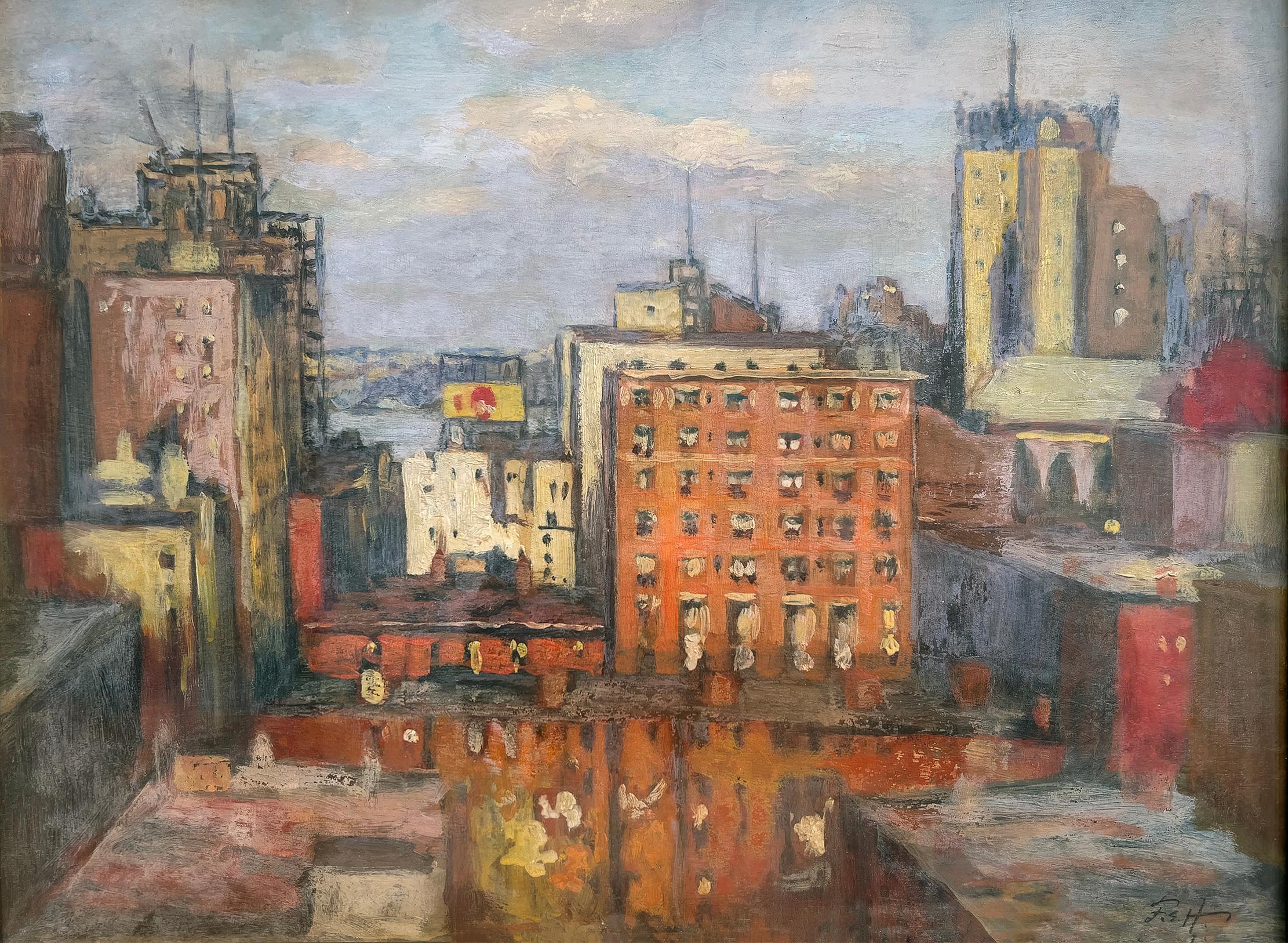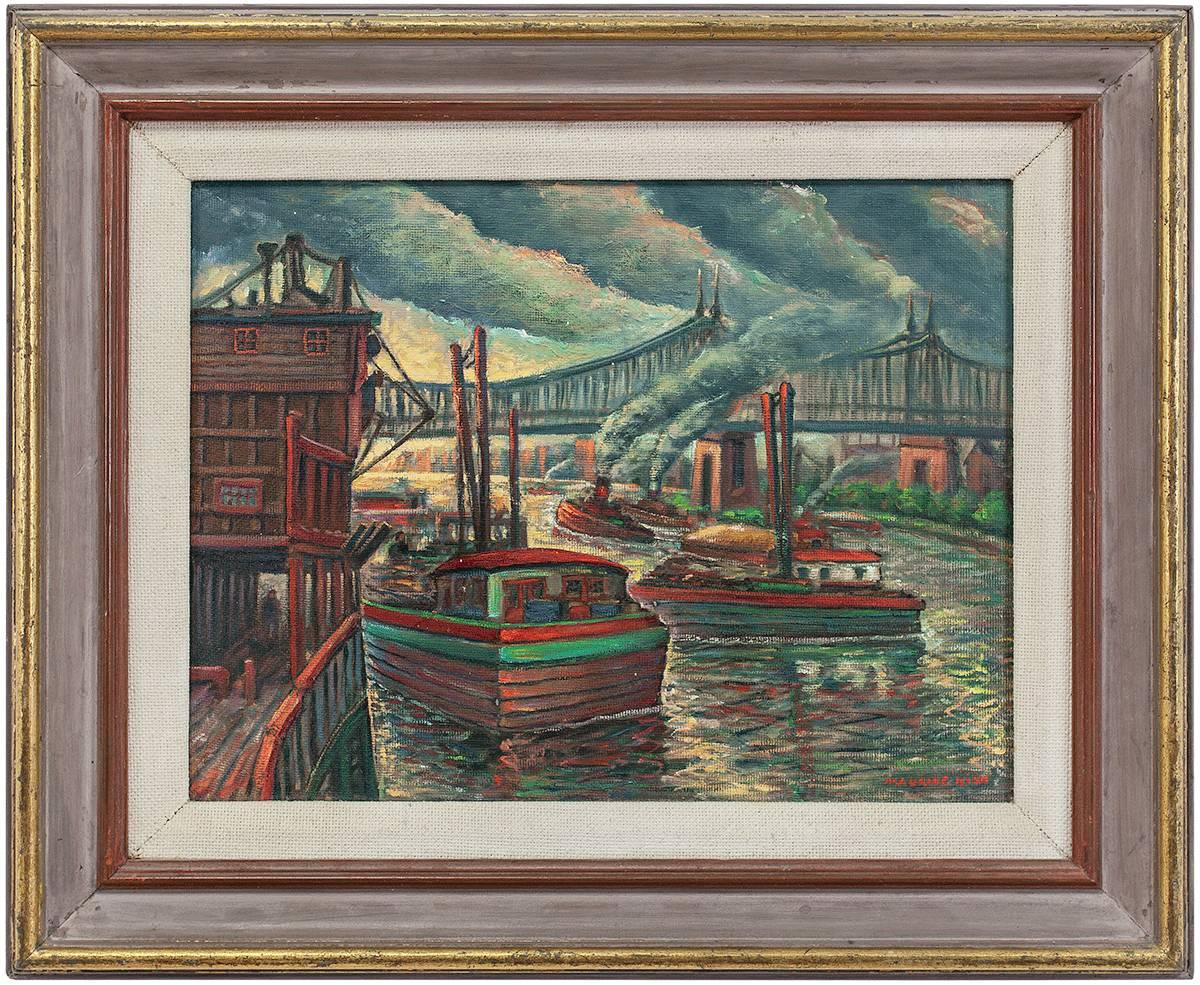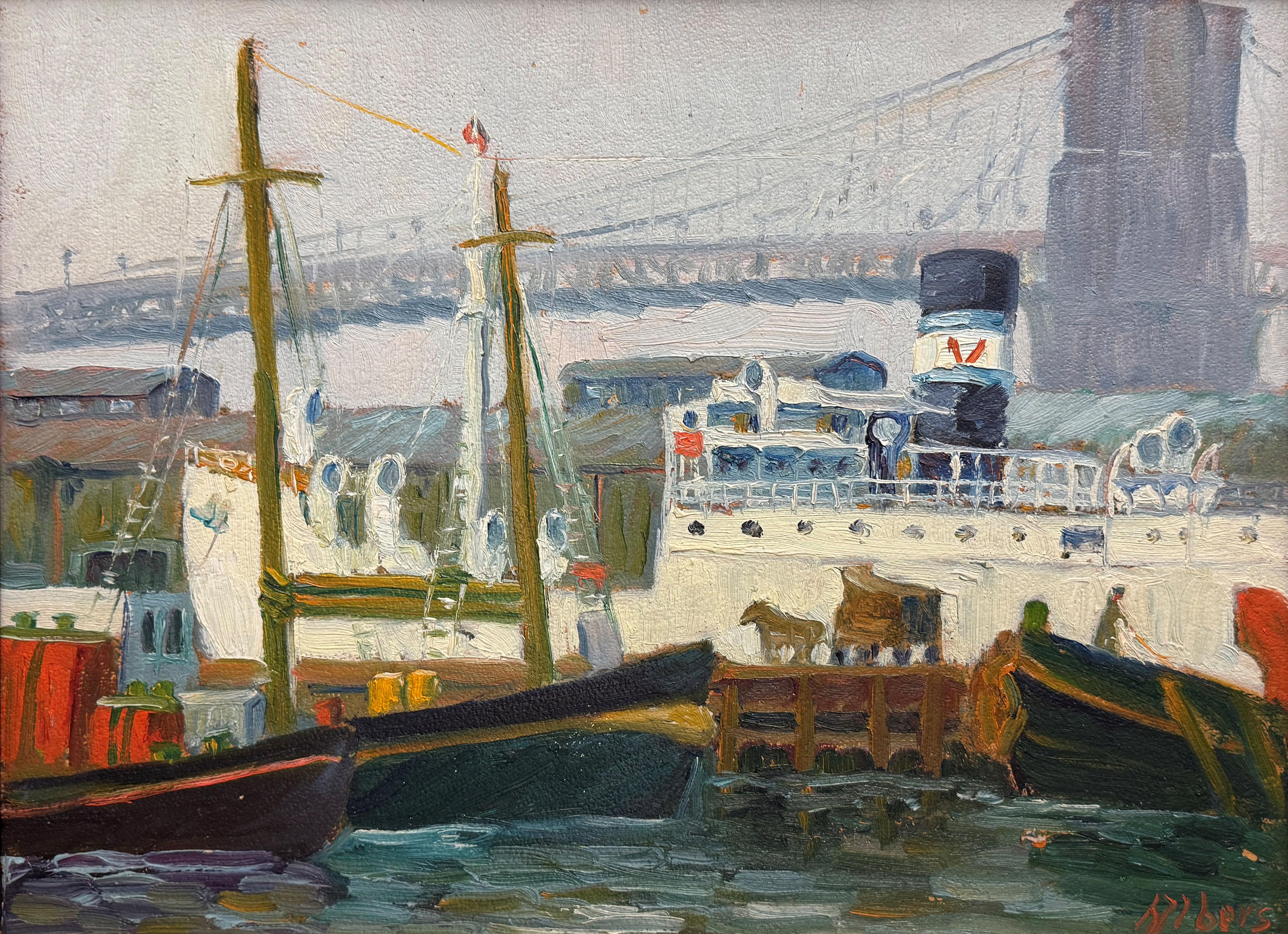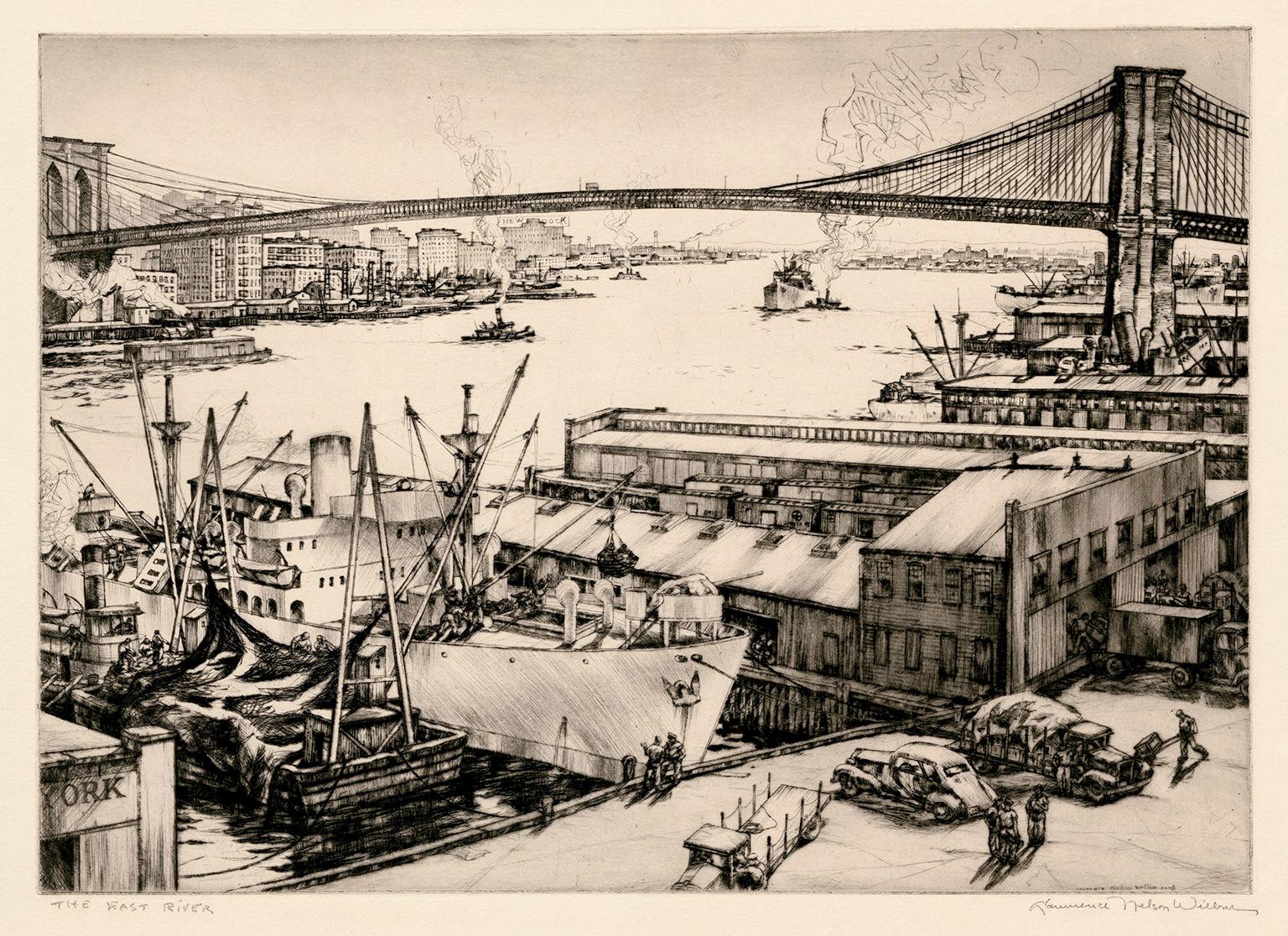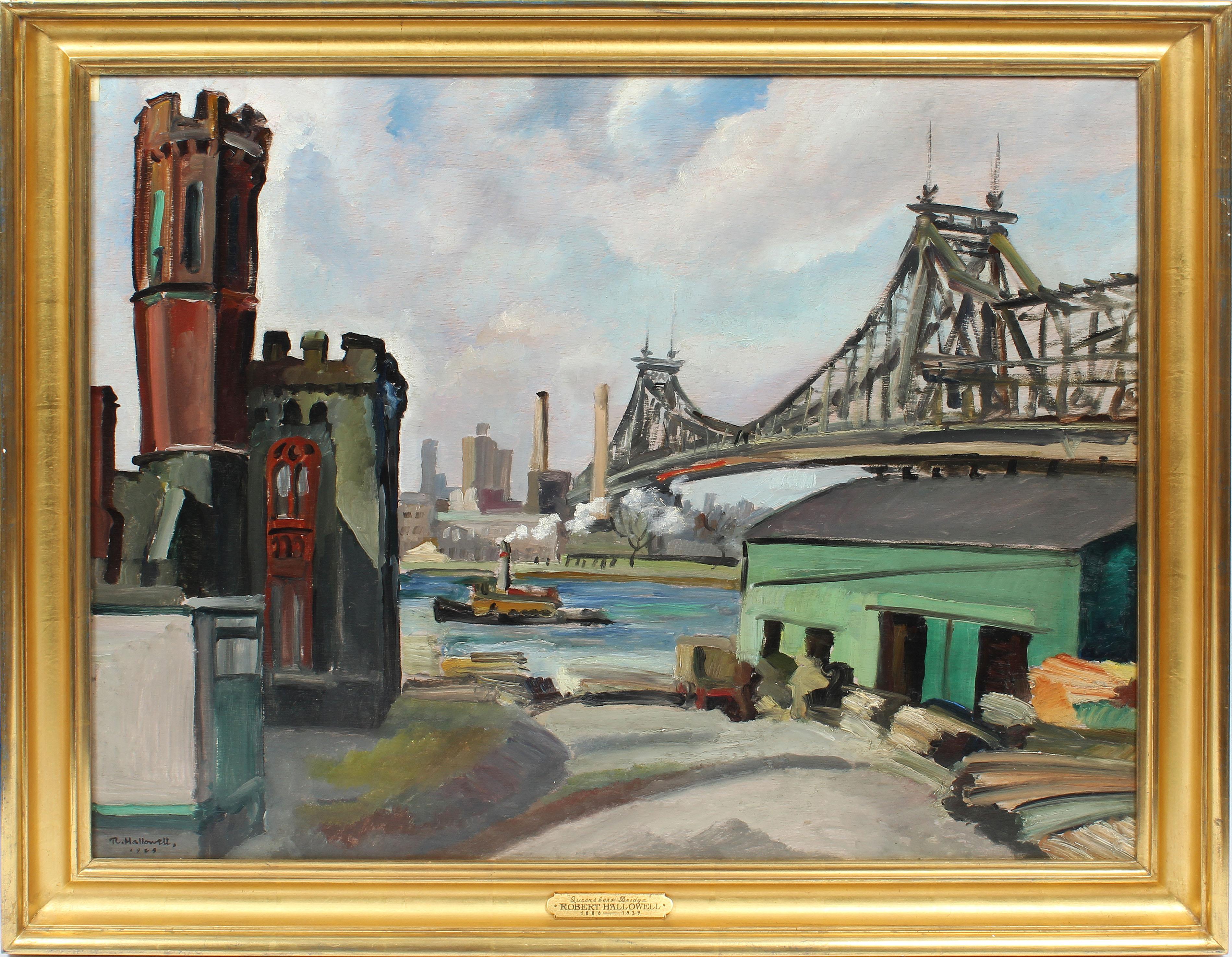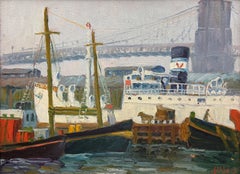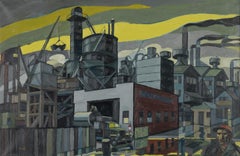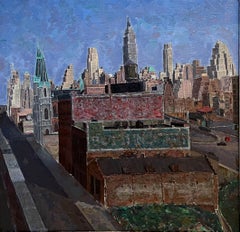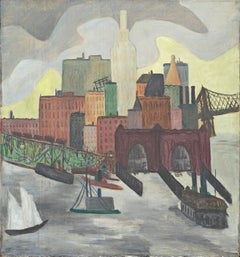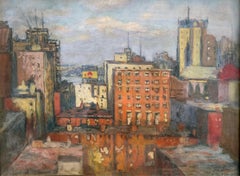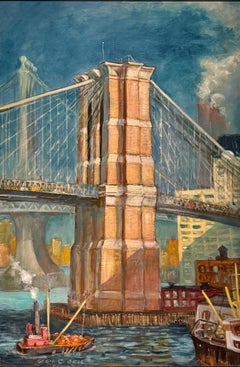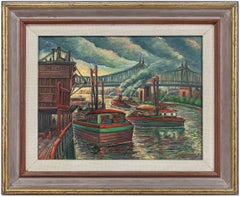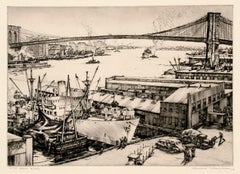Items Similar to "Building the Westside Highway" Frida Gugler, 1930s New York City Urban Scene
Want more images or videos?
Request additional images or videos from the seller
1 of 11
Frida Gugler"Building the Westside Highway" Frida Gugler, 1930s New York City Urban Scenecirca 1935-1937
circa 1935-1937
$12,000
£9,166.12
€10,532.91
CA$17,130.09
A$18,781.79
CHF 9,807.70
MX$226,015.27
NOK 123,610.46
SEK 116,225.63
DKK 78,661.34
About the Item
Frida Gugler
Building the Westside Highway (Near the George Washington Bridge), circa 1935-37
Signed lower right
Oil on canvas
20 x 28 inches
Born in Milwaukee, Wisconsin, the painter Frida Gugler studied at the school of the Art Institute of Chicago, Illinois, and took further work in France, Germany and Italy. Her landscape paintings are represented in private and public permanent collections, including the Vanderpoel Memorial Association, Chicago, Illinois, and the Milwaukee Art Institute, Wisconsin.
- Creator:Frida Gugler (1874 - 1966, American)
- Creation Year:circa 1935-1937
- Dimensions:Height: 28 in (71.12 cm)Width: 36 in (91.44 cm)
- More Editions & Sizes:Unique workPrice: $12,000
- Medium:
- Movement & Style:
- Period:
- Condition:
- Gallery Location:New York, NY
- Reference Number:1stDibs: LU1841216077642
About the Seller
5.0
Platinum Seller
Premium sellers with a 4.7+ rating and 24-hour response times
Established in 2022
1stDibs seller since 2022
123 sales on 1stDibs
Typical response time: <1 hour
- ShippingRetrieving quote...Shipping from: New York, NY
- Return Policy
Authenticity Guarantee
In the unlikely event there’s an issue with an item’s authenticity, contact us within 1 year for a full refund. DetailsMoney-Back Guarantee
If your item is not as described, is damaged in transit, or does not arrive, contact us within 7 days for a full refund. Details24-Hour Cancellation
You have a 24-hour grace period in which to reconsider your purchase, with no questions asked.Vetted Professional Sellers
Our world-class sellers must adhere to strict standards for service and quality, maintaining the integrity of our listings.Price-Match Guarantee
If you find that a seller listed the same item for a lower price elsewhere, we’ll match it.Trusted Global Delivery
Our best-in-class carrier network provides specialized shipping options worldwide, including custom delivery.More From This Seller
View All"The Ordell, Brooklyn Bridge" Margaretha E. Albers, New York Urban Cityscape
By Margaretha E. Albers
Located in New York, NY
Margaretha E. Albers
The Ordell, Brooklyn Bridge
Signed LR
Oil on artist board
12 x 16 inches
Provenance
Kennedy Galleries, New York
Private Collection, New York
St. Lifer Art, New...
Category
1930s American Realist Figurative Paintings
Materials
Oil, Board
"Colonial Sand and Stone Company, New York, " Industrial WPA Scene, Precisionist
By William Sharp
Located in New York, NY
William Sharp (1900 - 1961)
Factory on the River
Oil on canvas
20 1/2 x 28 1/2 inches
Initialed lower left: WS
Provenance:
Estate of the artist
Private Collection, New York
Swann Auction Galleries, American Art, June 13, 2019, Lot 178
Private Collection, New York
Colonial Sand and Stone Co., founded by Generoso Pope, was once the country’s largest sand and gravel business, providing the concrete for much of New York City’s skyline, including the Empire State Building, Rockefeller Center, Radio City Music Hall, airports and subways.
William Sharp was born on June 13, 1900, in Lemberg, Austria, where he attended college and the Academy for Arts and Industry. He later studied in Kraków, Poland, and in Berlin and Munich, Germany. Sharp began his career as a designer of stained-glass windows and as a painter of murals. He served in the German army during World War I. After the war he became a newspaper artist in Berlin and a well-known etcher.
Sharp drew political cartoons that were bitterly critical of the growing Nazi movement. As the influence of National Socialism intensified, he began to contribute drawings, under a pseudonym, to publications that were hostile to Hitler. After Hitler assumed power, Sharp was confronted with these drawings and told that he would be sent to a concentration camp. However, in 1934, he escaped to the United States.
His first newspaper assignment in America was making courtroom sketches for The New York Mirror...
Category
Mid-20th Century American Realist Landscape Paintings
Materials
Canvas, Paint, Oil
"Manhattan Looking East, " Herman Rose, WPA New York City View from Midtown
By Herman Rose
Located in New York, NY
Herman Rose (1909 - 2007)
Manhattan Looking East (View from Midtown), 1952-54
Oil on canvas
26 x 28 inches
Signed lower right
Fairfield Porter wrote an essay in ArtNews on this exact painting in 1955. Please inquire for a copy of the article.
Literature:
Fairfield Porter, "Herman Rose Paints a Picture," ArtNews, April 1955 Volume 54, Number 2, illustrated.
Herman Rose was best known for his depictions of cityscapes of New York City. Herman Rappaport was born in Brooklyn, New York. in 1909. Herman Rose was the professional pseudonym of Herman Rappaport. Originally trained as a draftsman and studied at the National Academy of Design from 1927 to 1929, he was later employed by the Works Progress Administration's Murals Division under Arshile Gorky from 1934 until 1939. In 1939, after experimenting with a variety of contemporary expressionistic styles, Rose decided to paint from life. Working mostly in East New York and East Canarsie in Brooklyn, and in Manhattan, Rose began to paint roof tops and street scenes.
Rappaport began using the name Herman Rose when he held his first solo art exhibition in 1946 at the Charles Egan Gallery in New York City. Although he initially began as an Expressionistic painter, he became known for small, light-filled Impressionist paintings of still life, cityscapes and skies by the early 1950s. His paintings and images were often composed of very small dabs of paint and tiny, blurry "squares," which combined to create the image on canvas, his favorite medium. Often described as a "lyrical painter" Rose's work "interpreted traditional subjects: landscape, still life and the figure like the Post-Impressionists from whom he developed his own style, Rose built up forms from distinct touches of color that don't entirely blend in the viewer's eye. This gives his surfaces an active quality that flattens forms, one of the great lessons of modernism."
Herman Rose's work received official recognition when Ms. Dorothy Miller of Museum of Modern Art (MoMA) included his work in an exhibition called, "15 Americans," alongside work by Clyfford Still, Mark Rothko and Jackson Pollock.
New York Times art critic Hilton Kramer wrote of Rose's work in 1981, "{he} must surely be counted among the most beautiful works anyone has produced in this challenging medium for many years." The Art in America art critic Lawrence Campbell...
Category
1950s American Modern Landscape Paintings
Materials
Canvas, Oil
"New York Skyline" Adelaide Lawson Gaylor, Modernist Landscape, Female Artist
Located in New York, NY
Adelaide Lawson Gaylor
New York Skyline, circa 1925
Oil on canvas
48 x 45 inches
Modernist artist Adelaide Jaffrey Lawson Gaylor was born in New York City and studied at the Art St...
Category
1920s American Modern Figurative Paintings
Materials
Canvas, Oil
"10th Avenue, Meatpacking District" Harry McCormick, New York City Urban Scene
By Harry McCormick
Located in New York, NY
Harry McCormick
10th Avenue, Meatpacking District, New York
Signed lower right
Oil on masonite
23 7/8 x 15 inches
Renowned for his exquisite depiction of light and shadow, Harry Mc...
Category
1970s Contemporary Landscape Paintings
Materials
Masonite, Oil
"Manhattan from the Rooftops" Nathan Hoffman, Impressionist Cityscape Landscape
Located in New York, NY
Nathan Hoffman
Manhattan from the Rooftops, July 1, 1947
Signed, dated and estate stamped on the reverse
Oil on board
15 3/4 x 20 inches
Born in Russia...
Category
1940s American Impressionist Landscape Paintings
Materials
Oil, Board
You May Also Like
New York Skyline the West Side with Hudson River - Vintage New York
By Frank S. Hermann
Located in Miami, FL
Rooftop view of the upper West Side Manhattan as it looked in the 1930s. There is a rough indication of a billboard and a glimpse of the Hudson River. The cluster of buildings depic...
Category
1930s American Impressionist Landscape Paintings
Materials
Oil, Gouache, Board
Brooklyn Bridge NYC American Scene Social Realism Mid 20th Century Modern WPA
By Cecil Crosley Bell
Located in New York, NY
Brooklyn Bridge NYC American Scene Social Realism Mid 20th Century Modern WPA
Cecil C. Bell (American, 1906-1970)
Brookyn Bridge amid the NYC Waterfront
35 ½ x 23 ½ inches
Oil on Bo...
Category
1930s American Realist Landscape Paintings
Materials
Oil, Board
Around East River, NYC Bridge, City Scene Oil Painting WPA Era 1940s
By Maurice Kish
Located in Surfside, FL
Genre: Modern
Subject: Marine Landscape
Medium: Oil
Surface: Canvas
Country: United States
Dimensions w/Frame: 20.5" x 24.5"
The imagery of Maurice Kish (1895-1987), whether factories or carousels, reliably subverts expectations. His vision hovers just around the unraveling edge of things, where what is solid and clear becomes ambiguous. He is fascinated, often delighted, by the falling apart. This unexpected, fresh perspective results in oddly affecting pictures of a now long-gone New York.
Born Moishe in a town called Dvinsk, Russia (what is now Daugavpils, Latvia), Kish came with his family to New York when he was in his teens. The family settled in Brownsville, and for the rest of Kish’s life Brooklyn remained his home, though he moved from one neighborhood to another. He was close to his parents, who recognized his talent and supported his desire to become an artist.
Kish attended the National Academy of Design as well as Cooper Union. His fellow students included many other immigrants and children of immigrants who were particularly receptive to the Modernism coming from Europe. As his career progressed, Kish himself applied different strains of Modernism to different purposes. For him, the story was held above all else.
For years, Kish used the skills he acquired in art school to earn his living at a Manhattan glass...
Category
Mid-20th Century Modern Landscape Paintings
Materials
Oil
'The East River', Brooklyn Bridge — Mid-Century Realism, New York City
By Lawrence Wilbur
Located in Myrtle Beach, SC
Lawrence Nelson Wilbur (1897-1988), 'The East River', drypoint, edition 65, 1946. Signed, titled, and annotated 'A. Jones Proof 1946' in pencil. Signed and dated in the plate, lower ...
Category
1940s American Modern Landscape Prints
Materials
Drypoint
Antique American Modernist Cityscape Ashcan School 59th Street Bridge Painting
By Robert Hallowell
Located in Buffalo, NY
Antique American ashcan school New York City oil painting by Robert Hallowell (1886 - 1939). Oil on board, circa 1929. Signed. Displayed in a period giltwood frame. Image, 30"L x 25"H.
Category
1920s Modern Landscape Paintings
Materials
Oil, Board
Brooklyn Transfer East River Crossing, Oil on Canvas Painting Frederick Reimers
Located in Atlanta, GA
"Bklyn Transfer, East River Crossing" by Frederick Reimers (1911–1994)
This unique, captivating cityscape painting by Frederick Reimers (USA, 1911–1994) offers a dynamic view of the ...
Category
20th Century Modern Landscape Paintings
Materials
Canvas, Oil, Acrylic
More Ways To Browse
1930s New York
George Washington Bridge
George Washington Signed
The Card Players
Vintage Christmas Illustrations
Zack Zdrale
1600 Oil Paint
19th Century Painting Girl With Dog
50 X 60 Painting
A J Milne
Antonio Mancini
Batman Painting
Bikash Bhattacharya
Brown And Bigelow
Collins Texas
Cuban Surrealist Paintings
Dan Parry
Demon Painting
